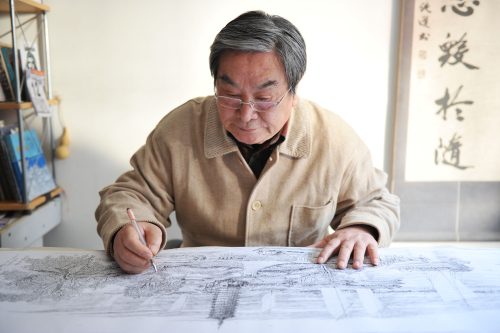|
"It's inevitable that things fade out of history due to natural disasters or damage. However, I can preserve historic memories through my paintings so that the generations to come will be able to know what Beijing was like," said Fang.
Fang is uncertain about how significant of a role his paintings can play, but he is committed to making the attempt.
One of his most notable works is a 7.8-meter-long scroll painting of Beijing's south-to-north central axis. Palaces, temples, altars and ancient government offices were built symmetrically along the axis when Beijing served as the imperial capital. The city was first made a national capital in A.D. 1153 during the Jin Dynasty (1115-1234), before going on to function as the capital of the ensuing Yuan (1271-1368), Ming (1368-1644) and Qing (1644-1911) dynasties.
The Beijing Municipal Government launched a bid to apply world cultural heritage status for the central axis in 2011 and Fang was named an ambassador for the initiative that year.
In his foreword to Legacy of the Old Capital, another collection of Fang's illustrations published in 2012, Luo Zhewen (1924-2012), noted expert on ancient Chinese architect, commented, "Fang has accurately recorded the hutongs, stores and lifestyles of old Beijing in pictures, which is a remarkable feat."
A secluded life
In order to be fully devoted to painting, Fang moved to his current abode in the suburban Tongzhou District, located about two hours' drive from the city center, in 2003. The quiet surroundings of his house have enabled him to focus on his art.
Fang said if he lived in downtown, his retired friends, who have a lot of leisure time, would frequently drop in for a visit--an often time-consuming burden. Now that he lives far from central Beijing, few people pay him a visit.
Fang, who has few hobbies aside from painting and gardening, spends most of his time creating paintings of old Beijing.
"My wife and I lead a simple life. We seldom dine out or shop for expensive items," said Fang. As Fang is presbyopic and does not know how to use the computer, his wife helps him do research for his artworks.
Fang is not alone in his quest to artistically depict old Beijing. Currently there are scores of painters engaged in the cause. Although these painters use differing techniques to draw different aspects of the city, they have one thing in common: They all cherish a deep love for the capital.
"As an artist who grew up in Beijing, Fang has deep affection toward the city," said Liu Lihua, Deputy Editor in Chief of New Star Press.
Despite his ripe age, Fang is still ambitious. He plans to host a solo exhibition of paintings of old Beijing in the near future. The exhibition will include 100 to 200 pictures larger in size than those included in his newly released collection and painted in the styles of both ancient Chinese paintings and Western oil paintings. He is currently in the process of drawing sketches for the exhibition.
Email us at:jijing@bjreview.com
 |
|
(WEI YAO) |
Profile
Fang Yan, born in north China's Hebei Province in 1941, came to Beijing with his parents at the age of 8. He developed a deep interest in painting from an early age and studied ancient Chinese masters to learn the art. During the early period of his career, he painted comic strips and book illustrations. Feeling remorseful for the disappearance of ancient architecture and traditional lifestyles, Fang began to paint scenes of old Beijing in the 1980s. Published collections of his pictures include Legacy of the Old Capital and Pictures of Old Beijing: Living Memories of the Ancient Capital. | 